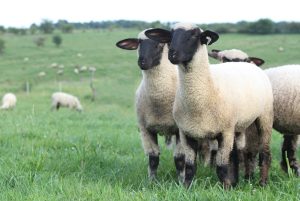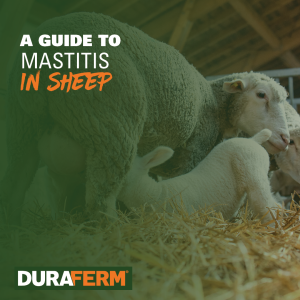
Sheep Embryo Transfer Protocol
The answer is complicated. After all, every veterinarian or E.T. specialist is going to have his or her own protocol when it comes to performing E.T. And, though we want to provide you the best information we can, the BioZyme team are not veterinarians.
Lambing time is here, which means the efforts of last year’s breeding season are coming to fruition. One thing is for sure. There is always room for improvement. So, what should you do to improve the outcomes of your sheep embryo transfer protocol (E.T.)?
What we do specialize in, though, is animal health and nutrition. At BioZyme®, we make quality supplements to help strengthen your stock and keep your flock nutritionally sound. What we do know for a fact, is…
Reproductive Success Begins with Nutrition
You can have the best veterinarian in the country perform your E.T. or artificial insemination (A.I.); however, without a sound nutrition protocol, your reproductive technologies might not be successful.
“Forty-five days before breeding, you need to make sure your ewes are on a good, oral mineral program like the one that DuraFerm offers,” said Sam Silvers, BioZyme’s Director of National Specialty Livestock.
DuraFerm® is a line of nutritional supplements for sheep and goats that supports optimal digestion and nutrition for maximized performance at every stage of production.
With three different formulas, there is a DuraFerm mineral ideal for any sheep flock’s operational goals in mind.
DuraFerm® Sheep Concept•Aid®
Are you looking for a loose mineral that is ideal for your flock’s year-round nutrition needs? DuraFerm Sheep Concept•Aid is a free-choice vitamin and mineral supplement for sheep designed to support reproductive success.
It contains AO-Biotics® Amaferm®, a prebiotic research-proven to enhance digestibility and high levels of vitamin E for reproductive tract repair. Additionally, it supports embryo production and conception using organic trace minerals.
DuraFerm® Sheep Concept•Aid® Protein Tub
Another quality product that might even be more ideal for setting up those ewes for flushing is the DuraFerm Sheep Concept•Aid Protein Tub. This protein tub with vitamins and minerals for sheep is designed to support reproductive success.
The 125-pound tub contains the Concept•Aid sheep mineral package in a 16% natural protein tub. It supports embryo production and conception using organic trace minerals and high levels of vitamin E. Like all DuraFerm products, it contains Amaferm to enhance digestibility.
DuraFerm® Sheep Concept•Aid® HEAT®
Keeping your ewes bred during the heat of the summer is critical. That is why we formulated DuraFerm® Sheep Concept•Aid® HEAT®, a free-choice vitamin and mineral supplement for designed to support reproductive success when temperatures are above 70 degrees.
This formula contains HEAT technology, a combination of essential oils and garlic, to support animals when heat and insects are a challenge. Of course, it still contains the Concept•Aid sheep mineral package and Amaferm to enhance digestibility.
Like the other two formulas, it supports embryo production and conception using organic trace minerals and high levels of vitamin E.
Health and Nutrition Work Together
When you want to boost the success of your sheep embryo transfer protocol, nutrition is key.
In addition to getting your flock on a premium nutrition program, Silvers reminds producers to set up the ewes with a good vaccination protocol. In addition to worming, he recommends vaccinating for C, D and T. Contact your veterinarian for specific vaccinations needed.
“Make sure your ewes are wormed, vaccinated and sheared 45 days prior to breeding,” he said.
Due to the fact that many sheep producers breed in the summer when mosquitoes are alive and well, both internal and external insecticides are recommended. Cache Valley Virus is one of the challenges that sheep breeders face that can be costly to their lamb crop and bottom line. Mosquito prevention is one of the best ways to be sure your ewes don’t succumb to CVV.
What should You Do?
Feed a Balanced Ration
Your flock’s ration should provide adequate energy and protein, in addition to the mineral package you are offering. Typically, good-quality pasture and a good-quality mineral mix provide sufficient nutrients to support the pregnancy.
However, pay close attention to pastures during the first 45 days of gestation. Legumes and red clover in particular, produce phytoestrogens. These estrogenic compounds can impact reproduction by reducing ovulation and conception rates.
Provide Plenty of Water
Water is the most essential nutrient for every living being. Many biological functions, including growth, development, and reproduction depend on adequate water in the diet. Make sure your flock has plenty of fresh, clean cool water.
This is especially true in the heat of the summer when many producers are in the heart of breeding season. Don’t limit water intake, and always make sure the supply is cool and plentiful.
Keep the Environment Clean, Cool
If your flock isn’t already sheared, make sure they are sheared before breeding season. This helps keep them cool, helping them settle their pregnancy. It also prevents external parasites like tics from having a place to live.
Silvers also recommends keeping your flock in a cool, well-shaded dry lot. If they are indoors, they also need to be on dry bedding with good ventilation and plenty of air circulation. Make sure there is no standing water or waste piles nearby, as those are ideal breeding areas for mosquitoes, one of the nuisances sheep breeders try to avoid as carriers of Cache Valley Virus.
Commit to Post-breeding Care
What you may not know is that once you’ve followed through with a sheep embryo transfer protocol, what comes after is just as important.
Once your veterinarian or breeding tech has implanted the eggs, and your flock is bred, the wait begins. It is vital to keep your ewes on a vitamin and mineral program like one of the DuraFerm products we mentioned above. Keeping them on a good plane of nutrition is vital to their reproductive success.
Invest in Nutrition
Make sure you keep your sheep on a good feeding program too. During gestation and lactation, their nutritional needs are the highest. In addition to water, vitamins and minerals, they also require protein, energy and fiber. This will dramatically improve the likelihood of the success of your sheep embryo transfer protocol.
With regards to nutrition, here’s what you need to keep in mind:
Energy
Energy makes up the largest portion of the sheep’s diet. Carbohydrates are the major sources of energy. The primary energy sources in the diets for these small ruminants are pasture, hay, silage and grain.
Meeting energy requirements without over or underfeeding animals can be a challenge. An energy deficiency will appear in several ways, depending on the production phase. In reproducing females, early signs of an energy deficiency are reduced conception rates, fewer multiple births and reduced milk production.
Excessive energy is also a challenge, as extra energy is stored as fat. Over-conditioned animals of both genders are not as reproductively sound. Females in late gestation are more apt to suffer from pregnancy toxemia and dystocia.
Protein
Protein requirements are highest for lactating ewes that are producing milk proteins or for young, growing animals that are building muscle.
The most common protein supplement for sheep is soybean meal. Other less common sources include sunflower meal, cottonseed meal, whole cottonseed, whole soybeans, peanut meal, canola (rapeseed) meal, fish meal and alfalfa pellets.
Protein blocks or tubs, like the DuraFerm Sheep Concept•Aid Protein Tub are another good source of protein for all ages of sheep. They are often offered with a total vitamin and mineral package.
Fiber or Forage
Sheep are ruminants, meaning they have four-compartment stomachs especially designed to digest roughage like grass, hay and silage. Forage adds bulk to the diet and keeps the rumen functioning properly by increasing rumination and salivation.
Most nutritionists agree that sheep should always have roughage in their diets, at least one pound per head per day. Sheep that do not consume adequate forage may chew on wood or wool.
Reduce Stress
Finally, Silvers reminds producers to keep the stress of bred animals to a minimum. Reduce handling the ewes, keep predators, or unknown animals or people away from them, and continue to keep watch over them. Look for any unusual signs or symptoms they might not feel well, and treat them according to a veterinarian’s treatment plan.
BioZyme Provides Care that Comes Full Circle
We know that getting your ewes bred and keeping them bred is important to you as a producer. It means more live lambs, and it means more to your bottom line. That is why we make products that we also use and trust ourselves.
Silvers feeds his own flock the DuraFerm products because he believes in the Amaferm advantage that keeps his ewes healthy. They are more likely to produce healthy lambs. He is a believer in the DuraFerm Protein Tub, and he has it available to the lambs early on.
“They (the lambs) will hit the tub first before anything else. That’s what I want, to get that protein in their diet, to get that rumen working. Get some Amaferm in their diet, and they seem to get a better start. They are going to see what mom is doing. That’s how they learn so if they see mom lick that tub, they usually hit the tub first. Get their gut working, give them a little boost of energy. Get ‘em started on creep a little faster,” Silvers said, of his lambs that usually discover DuraFerm Protein Tubs within the first two to three weeks of age.
Get your Flock on DuraFerm
Do you want to set your ewes up for a successful embryo transfer protocol with the nutritional benefits of DuraFerm? You can! Find a dealer near you to get yours today!
Learn more about DuraFerm and keep up on the latest news. Sign up for our e-newsletter.

